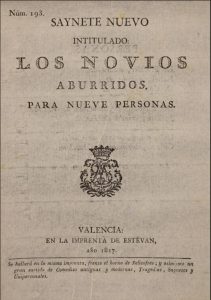Enjoy this post by Elena Echavarria, one of our Special Collections Freshman Fellows for the 2021-2022 academic year!
Translation has always been a part of my daily life, both when I attended an American school in Colombia but especially since I moved from my Spanish-speaking home to the United States. Throughout the three years I’ve lived in the United States, the translation process in my head has become streamlined. However, I’m still hyper-aware of the connotations, meanings, and sound of particular words, and there have been many times when Spanish idioms have made their way into my English conversations. I never considered that the processes I’ve developed in the last few years could be helpful academically until I had the opportunity to join the Special Collections Freshman Fellowship. Through this fellowship my advisor, Mackenzie Zalin, and I have been working on translating “Los Novios Aburridos,” a 19th-century Spanish farce about the suitors of a young woman. This farce is a type of Spanish theatrical production called a saynete, which could be performed during a longer play’s intermission.

I began the translation process by looking through the Special Collections catalog of 19th-century saynetes, which included several stories of murders, alchemists, mayors, and generally any and every humorous plot twist imaginable. I settled on “Los Novios Aburridos”, a title that roughly translates to “The Annoyed Suitors.” The comedy tells the story of Isabel, a young woman of marriageable age who has a beloved she wants to marry. However, her father and aunt have each selected an older man for Isabel to marry. The servants of the household, who know the entire situation, consequently precipitate the plot into chaos and scheme to set up Isabel with her beloved. When I first read the story, I was fascinated by how the characters’ different desires interweave and clash against one another, creating humorous and complex arcs and relationships within the text. However, this saynete was published in 1817, meaning that not all the grammar, syntax, and idioms line up to modern-day Spanish. There are several sections of the story that I did not fully grasp until I combed through pages and pages of definitions and alternative meanings to words.
Some particularly challenging sections of the text to translate are its exclamations because they are deeply grounded in the time period. For example, in the play, one of the servants continuously exclaims, “¡Malo con dos mil demonios!” which literally translates to “bad with two thousand demons.” I can’t find any reference source that mentions this exclamation and it is one that I am still thinking about how to translate in the context of the play. Some of these exclamations have been so hard to pin in their original context that I’ve had to highlight them and move on, opting to revisit them once the majority of the play is translated.
By this point, I have translated about half of this saynete, which has a length of around 12 pages. However, beyond all of the fun I have had pinning down the connotation and the flow of words, one of the most entertaining aspects of this piece is how over the top some of its characters act. For example, in “Los Novios Aburridos,” the maid, Jacinta, disguises herself; she lies to several people to pull off her schemes, resulting in a colorful and dynamic implied visual dimension in this text. I was inspired by the visual elements and the costumes mentioned in the play’s stage notes and decided that illustrating the play could add an interesting visual dimension that might bring the servant/master and era-based relationships into a more modern context.
Working to translate “Los Novios Aburridos” has been a challenging but rewarding process of continual revision and analysis. Nailing down the correct context, connotations and implied meanings of antiquated Spanish vernacular has allowed me to reconnect with my first language and to learn more about it. I look forward to continuing to work on this saynete, illustrating it and perhaps picking another one to work on through the end of the school year.
